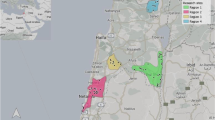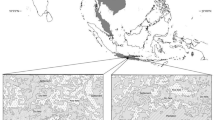Abstract
The African wild dog (AWD) (Lycaon pictus) is a critically endangered species. These animals are hypercarnivores, hunting mostly medium-sized antelope. In this study, using bacterial tag-encoded FLX-Titanium amplicon pyrosequencing (bTEFAP®), the microbiota in the fecal material of AWDs living in the Great Plains Zoo & Delbridge Museum of Natural History was investigated. In both samples, the most predominant bacterial phylum was the Firmicutes with members of the genus Blautia spp. being the most dominant bacteria.
Similar content being viewed by others
Data availability
The NGS data have been deposited in the Sequence Read Archive under accession numbers SRX10894549 and SRX10894550.
Code availability
Not applicable.
References
Biasato I, Ferrocino I, Colombino E, Gai F, Schiavone A, Cocolin L, Vincenti V, Capucchio MT, Gasco L (2020) Effects of dietary Hermetia illucens meal inclusion on cecal microbiota and small intestinal mucin dynamics and infiltration with immune cells of weaned piglets. J Anim Sci Biotechnol 11:64
Chavez DE, Gronau I, Hains T, Kliver S, Koepfli KP, Wayne RK (2019) Comparative genomics provides new insights into the remarkable adaptations of the African wild dog (Lycaon pictus). Sci Rep 9:8329
Chen J, Shang S, Wu X, Zhong H, Zhang H (2017) The microbial community in the feces of cape oryx (Oryx gazella) as determined by high throughput Illumina sequencing technology. Pak J Zool 49:9
Creel S, Creel MN (2002) The African wild dog behavior, ecology, and conservation. Princeton University Press, Princeton/ Oxford
Ghosh S, Whitley CS, Haribabu B, Jala VR (2021) Regulation of intestinal barrier function by microbial metabolites. Cell Mol Gastroenterol Hepatol 11:1463–1482
Guass O, Haapanen LM, Dowd SE, Širović A, McLaughlin RW (2016) Analysis of the microbial diversity in faecal material of the endangered blue whale, Balaenoptera musculus. Antonie Van Leeuwenhoek 109:1063–1069
Handl S, Dowd SE, Garcia-Mazcorro JF, Steiner JM, Suchodolski JS (2011) Massive parallel 16S rRNA gene pyrosequencing reveals highly diverse fecal bacterial and fungal communities in healthy dogs and cats. FEMS Microbiol Ecol 76:301–310
Hartstone-Rose A, Werdelin L, De Ruiter DJ, Berger LR, Churchill SE (2010) The Plio-Pleistocene ancestor of wild dogs, Lycaon sekowei n. sp. J Paleont 84:299–308
Hayward MW, O’Brien J, Hofmeyr M, Kerley G (2006) Prey preferences of the African wild dog Lycaon pictus (Canidae: Carnivora): ecological requirements for conservation. J Mammal 87:1122–1131
Hristov AN, Callaway TR, Lee C, Dowd SE (2012) Rumen bacterial, archaeal, and fungal diversity of dairy cows in response to ingestion of lauric or myristic acid. J Anim Sci 90:4449–4457
Jenq RR, Taur Y, Devlin SM, Ponce DM, Goldberg JD, Ahr KF, Littmann ER, Ling L, Gobourne AC, Miller LC, Docampo MD, Peled JU, Arpaia N, Cross JR, Peets TK, Lumish MA, Shono Y, Dudakov JA, Poeck H, Hanash AM, Barker JN, Perales MA, Giralt SA, Pamer EG, van den Brink MR (2015) Intestinal Blautia is associated with reduced death from graft-versus-host disease. Biol Blood Marrow Transplant 21:1373–1383
Ley RE, Hamady M, Lozupone C, Turnbaugh PJ, Ramey RR, Bircher JS, Schlegel ML, Tucker TA, Schrenzel MD, Knight R, Gordon JI (2008) Evolution of mammals and their gut microbes. Science 320:1647–1651
Lynch J, Hsiao E (2019) Microbiomes as sources of emergent host phenotypes. Science 365:1405–1409
Milani C, Duranti S, Bottacini F, Casey E, Turroni F, Mahony J, Belzer C, Delgado Palacio S, Arboleya Montes S, Mancabelli L, Lugli GA, Rodriguez JM, Bode L, de Vos W, Gueimonde M, Margolles A, van Sinderen D, Ventura M (2017) The first microbial colonizers of the human gut: composition, activities, and health implications of the infant gut microbiota. Microbiol Mol Biol Rev 81:e00036-e117
Nelson TM, Rogers TL, Brown MV (2013) The gut bacterial community of mammals from marine and terrestrial habitats. PLoS ONE 8:e83655
Ozato N, Saito S, Yamaguchi T, Katashima M, Tokuda I, Sawada K, Katsuragi Y, Kakuta M, Imoto S, Ihara K, Nakaji S (2019) Blautia genus associated with visceral fat accumulation in adults 20–76 years of age. NPJ Biofilms Microbiomes 5:28
Rajendiran E, Ramadass B, Ramprasath V (2020) Understanding connections and roles of gut microbiome in cardiovascular diseases. Can J Microbiol 67:101–111
Sekirov I, Russell SL, Antunes LC, Finlay BB (2010) Gut microbiota in health and disease. Physiol Rev 90:859–904
Shumba T, Montgomery RA, Sillero-Zubiri C, Rasmussen GSA (2017) Morphological variation of wild dogs across Africa. Int J Zool Appl Biosci 2:145–154
Stephens WZ, Burns AR, Stagaman K, Wong S, Rawls JF, Guillemin K, Bohannan BJ (2016) The composition of the zebrafish intestinal microbial community varies across development. ISME J 10:644–654
Toh K, Wade CM, Mikkelsen TS, Karlsson EK, Jaffe DB (2005) Genome sequence, comparative analysis and haplotype structure of the domestic dog. Nature 438:803–819
Wan Y, Wang F, Yuan J, Li J, Jiang D, Zhang J, Li H, Wang R, Tang J, Huang T, Zheng J, Sinclair AJ, Mann J, Li D (2019) Effects of dietary fat on gut microbiota and faecal metabolites, and their relationship with cardiometabolic risk factors: a 6-month randomised controlled-feeding trial. Gut 68:1417–1429
Woodroffe R, Ginsberg JR (1998) Edge effects and the extinction of populations inside protected areas. Science 280:2126–2128
Woodroffe R, Lindsey PA, Romanach SS, Ranah SMK (2007) African wild dogs (Lycaon pictus) can subsist on small prey: implications for conservation. J Mammal 88:181–193
Woodroffe R, Sillero-Zubiri C (2020) Lycaon pictus (amended version of 2012 assessment). In: ICUN 2020. The IUCN red list of threatened species
Wu X, Zhang H, Chen J, Shang S, Wei Q, Yan J, Tu X (2016) Comparison of the fecal microbiota of dholes high-throughput Illumina sequencing of the V3–V4 region of the 16S rRNA gene. Appl Microbiol Biotechnol 100:3577–3586
Wu X, Zhang H, Chen J, Shang S, Yan J, Chen Y, Tang X, Zhang H (2017) Analysis and comparison of the wolf microbiome under different environmental factors using three different data of next generation sequencing. Sci Rep 7:11332
Zhang H, Chen L (2010) Phylogenetic analysis of 16S rRNA gene sequences reveals distal gut bacterial diversity in wild wolves (Canis lupus). Mol Biol Rep 37:4013–4022
Zhu L, Wu Q, Deng C, Zhang M, Zhang C, Chen H, Lu G, Wei F (2018) Adaptive evolution to a high purine and fat diet of carnivorans revealed by gut microbiomes and host genomes. Environ Microbiol 20:1711–1722
Acknowledgements
This research was done as part of a Provost Honors project under the leadership of Zina Haywood, Executive Vice President/Provost. We also thank Jorge Nieto, Nicole Dutton and Donald Zakutansky for their enthusiastic support of this research.
Funding
This project was supported by funding provided by Gateway Technical College and by the Gateway Foundation.
Author information
Authors and Affiliations
Contributions
FAS and RWM designed this project. JB provided the fecal samples and information about the African wild dogs used in this study. SED was responsible for bTEFAP® and data collecting. FAS and RWM analyzed data. FAS and RWM wrote the manuscript. All authors contributed to discussions and revisions, and approved the final manuscript.
Corresponding author
Ethics declarations
Conflict of interest
The authors declare that they have no conflict of interest. All the authors read and approved the final manuscript.
Additional information
Communicated by Erko Stackebrandt.
Publisher's Note
Springer Nature remains neutral with regard to jurisdictional claims in published maps and institutional affiliations.
Supplementary Information
Below is the link to the electronic supplementary material.
Rights and permissions
About this article
Cite this article
Sanchez, F.A., Dowd, S.E., Brandt, J. et al. Analysis of the microbial diversity in the fecal material of the critically endangered African wild dog, Lycaon pictus. Arch Microbiol 204, 42 (2022). https://doi.org/10.1007/s00203-021-02678-9
Received:
Revised:
Accepted:
Published:
DOI: https://doi.org/10.1007/s00203-021-02678-9




